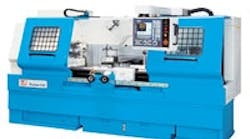German owned Knuth Machine Tools USA, Lincolnshire, Ill., has been in business since 1923, with manufacturing plants in Germany, Turkey and China, offering chip-making and forming equipment in both manual and CNC formats.
Manual machine types include a broad spectrum such as mills, lathes, drills, and saws, says Angus Catterson, general manager. Among his small customers typical applications tend to involve short runs and simple part configuration. Catterson says his larger customers want manual machines for repair work in maintenance departments and for one-off specials in a production process. If only one or two parts are required, a machinist can turn one out much more quickly on a manual machine than could be done on a CNC. On production runs the CNC is faster, he adds. Sometimes manual equipment is teamed with CNC machines to perform the occasional secondary operation.
More design changes have occurred in the controls and electrics than the iron itself, adds Catterson. "For example, we have very accurate digital readouts on a minimum of three axes on every machine. Readouts speed the production of accurate parts," he explains. Computerized control of the spindle is available on some manual lathes to optimize surface finish by controlling the surface feet per minute at the cutting tool. No programming is involved, adds Catterson.
Catterson also notes that the strategic value of manual machines in product development and repair supports market demand even in an economy that is offshoring high-volume manufacturing.
For the future, Catterson sees more design efforts to bridge the operating modes of manual and CNC machines. One example in the Knuth lineup is a CNC lathe that comes with full manual controls. "What that enables you to do is run a part manually, and then after the first good part is produced, a push of a button will enable the CNC to duplicate the machining cycle for subsequent parts." In addition to easy access as a manual machine, the machine can operate in a CNC mode without the need for programming.
See Also



